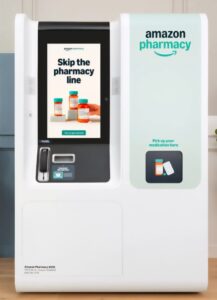In December 2025, Amazon is rolling out in-office prescription kiosks at its One Medical clinics. The goal is simple but ambitious: streamline medication fulfillment, boost adherence, and reduce the number of prescriptions that go unfilled. Here’s what this could mean for patients, providers, and traditional pharmacies.
How the kiosks work
- Fast, in-office pick-ups: Patients can receive their medication minutes after their doctor visit, eliminating an extra trip to a separate pharmacy.
- Direct-to-patient flow: After a provider sends a prescription to Amazon Pharmacy, patients pay via the Amazon app, get a QR code, and pick up at the on-site kiosk.
- Integrated digital experience: The Amazon app surfaces upfront costs, insurance co-pays, and manufacturer coupons for a smoother financial planning.
- Remote pharmacist oversight: A licensed Amazon pharmacist reviews every order. Patients can connect with a pharmacist for a consultation via video or phone from the app or kiosk.
- Addressing “pharmacy deserts”: By embedding kiosks in medical offices, Amazon aims to bring essential medications closer to neighborhoods with limited pharmacy access.
Why this matters for patients
- Convenience and speed: No extra trip required; medications can be ready minutes after a visit.
- Clear costs upfront: See prices, insurance co-pays, and coupons before paying.
- Access to pharmacist support: Consult with a pharmacist without leaving the kiosk or app.
- Potentially better adherence: Reducing friction points can help patients stick to their medication regimens, especially for chronic conditions.
What this could mean for traditional pharmacies
- Shifting convenience dynamics: The convenience of in-office fulfillment challenges the traditional pharmacy trip as the default shopping experience for medications.
- New workflows for providers and clinics: Prescriptions flow directly to Amazon Pharmacy, which may alter coordination between care teams and pharmacy services.
- Hybrid channel dynamics: This model blends point-of-care service with digital commerce, potentially complementing rather than replacing traditional pharmacies—at least in the near term.
- Pharmacist roles evolve: While orders are automated, pharmacist oversight remains. This could expand access to pharmacist consultations at the point of care, potentially easing demand on standalone pharmacies in some communities.
- Adherence outcomes: Streamlined fulfillment could reduce missed fills, a major hurdle for chronic disease management.
- Equity considerations: If kiosk access relies on integration with specific clinics and the broader Amazon ecosystem, gaps could persist in communities with limited digital access or clinic availability.
A closer look at the patient journey
- Visit with a clinician.
- Provider sends the prescription to Amazon Pharmacy.
- Use the Amazon app to pay and receive a QR code.
- Pick up the medication from the on-site kiosk or access pharmacist support via video/phone if needed.
- This streamlined flow minimizes interruptions in care and makes it easier for patients to stay on track with their treatment plans.
Questions and considerations worth watching
- How will traditional pharmacies respond, particularly in regions with fewer Amazon touchpoints?
- Could on-site kiosks impact wait times or fulfillment speed for non-Amazon prescriptions in the same facility?
- How will privacy and HIPAA compliance be safeguarded across both digital and in-person components?
- What will be the impact on loyalty programs, insurance partnerships, and price competition in the broader pharmacy landscape?
- Will this model scale beyond One Medical clinics, and how will it perform in rural or underserved areas?
The broader outlook
Amazon’s prescription kiosks signal a larger trend toward tighter integration of care delivery and digital commerce. If the model proves effective, it could push traditional pharmacies to accelerate innovations, think enhanced tele pharmacy, more robust digital prescription workflows, and closer collaboration between clinics and pharmacies.
Yet the transition will likely be gradual. Collaboration between traditional pharmacies and the new kiosk model may emerge, with clinics and pharmacies co-creating experiences that prioritize patient convenience and adherence.
Final thought
The in-office prescription kiosk is more than a convenience feature; it’s a reimagining of how care teams and patients interact around medication. As this pilot rolls out, it will be fascinating to watch how patients respond, how providers integrate these workflows, and how traditional pharmacies adapt in this evolving landscape.

